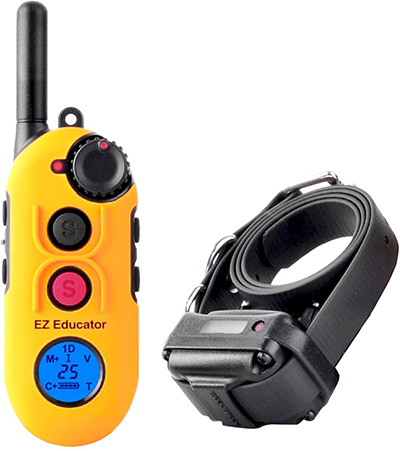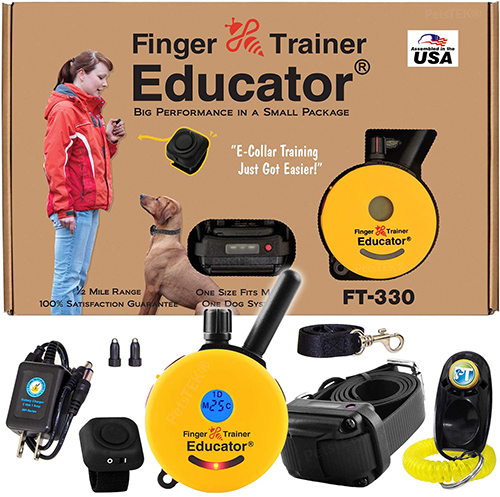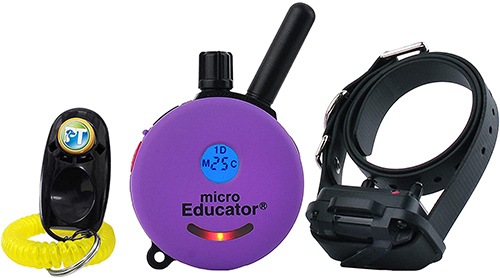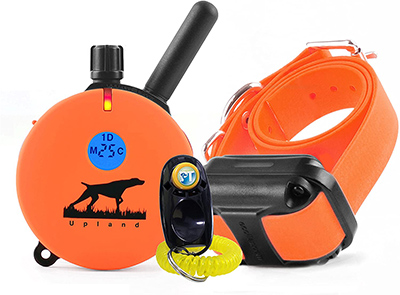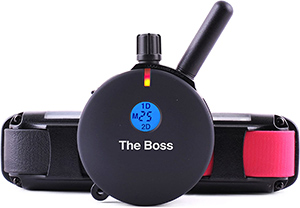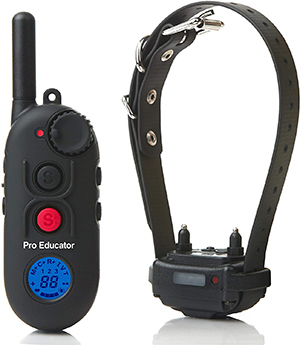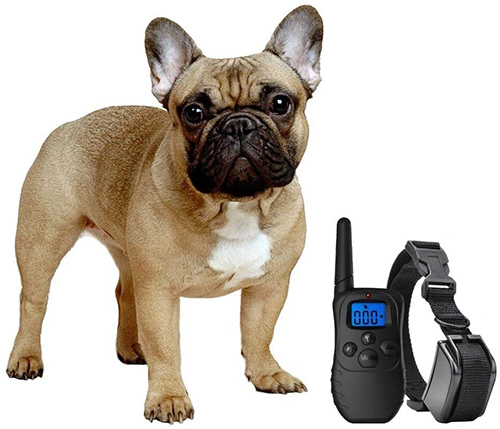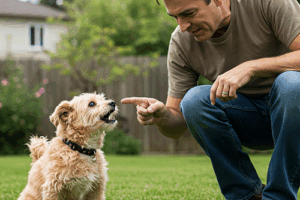
When looking at the instructions for dog e-collars, some may seem confident that they have all the information they need. Unfortunately, you couldn’t be more wrong. Although companies provide detailed instructions when you purchase their dog e-collars, it can still be overwhelming for dog owners for various reasons. First, each breed will react differently to the e-collar; this is a reality because of their personality and willingness to be trained.
For example, some dogs struggle with electronic collars because of their independent personality and unwillingness to please their owners, unlike other more loyal breeds. Also, each button will have a different reaction on the dog and make them react in different ways to the e-collar. This issue can make it seem like you’re doing something wrong. However, it would help if you didn’t overreact to your dog’s reactions to the buttons because that can throw her off also.
Dogs can sense how you feel. For instance, if you were to press a button on the e-collar and they take a step back, most owners are going to think that they hurt them. Dogs tend to sense this, which causes them more stress and uncertainty with the e-collar training.
What are Dog E-Collars?
Over thirty years ago, the very first electronic dog collar made its debut and was initially used to train hunting dogs. However, there were mixed reviews. Dog owners were excited and worried about how these collars would affect their dogs. Some thought they were an excellent training tool, and some thought they were harmful. The first e-collar only delivered one level of stimulation. Today, there are about three stimulation levels: low, medium, and high, along with different intensity ranges.
Stimulation Levels of Dog E-collars
Over the last thirty years, it is safe to say that the e-collars we have today are safer, made for all types of dogs, and are an excellent training tool. The e-collar is nothing but a collar with a radio receiver attached. The radio receives the signal from the transmitter, which delivers your dog a small electrical shock, similar to you getting shocked by static electricity. The slight shock gets your dog’s attention just enough to know that what she’s doing is inappropriate.
Given time, your dog will learn right and wrong thanks to training with the e-collar. The majority of people that choose dog e-collars simply don’t want to train their dogs with a leash. Another popular reason people choose these collars is that they want to train their dog from a small distance. For example, if you’re with your dog at the park, and she starts to run off after a squirrel, instead of yelling commands, you press the button. Your dog will stop running and come back to you.
At this level, you have trained your dog to respond to the shock by looking at you to see what you want. For instance, you will need to command them to come back, or you will give a sit command if you want them to sit. Dog e-collars can be purchased at most pet stores or online. If you’re new to working with these collars, I recommend getting them from your local pet store, where you can get help in understanding how to use the collar from sales associates. Pet store employees are also great at answering questions and can give you demonstrations of different settings and how it works.
The Different Types of E-Collars
When finding the best e-collar for your dog, think of why you’re training them. These collars are not always used for basic dog training. Some are more geared toward yard use, while others are used for hunting, barking, and working dogs.
Yard training
These e-collars are mainly for pets, but some can be used for other training purposes. They are some of the most common collars and give you various options. The EZ-900 easy educator is an e-collar that mainly focuses on the dog’s safety. Its stimulation level reaches 100, and its boosting level goes to 60.
This model is thought to be the most humane on the market. This e-collar is an ideal size for smaller type dogs. Dog owners love that you do not see the head jerking with this model as you see with others. The EZ-900 can be used up to half a mile and used for working, training, and hunting. Another great benefit of this collar is that it is one of the cheapest.
The ET-302 educator is another e-collar with a range of half a mile. The stimulation level goes to 100 and can hold boosting levels from 1 to 60. It also comes with a collar that can help you locate your dog in the dark and is waterproof. This collar is excellent for any dog, has two receivers, and is mainly for yard use.
The ET-402 educator holds stimulation levels from 1 to 100 and boosting levels of 1 to 60. The e-collar can reach up to 3 quarters of a mile and is excellent for emergencies. It is waterproof and includes a light. Any size dog can utilize this collar, but it is mainly for yard training.
The FT-330 finger trainer educator is a newer model and can reach up to half a mile. Although the collar is small, it holds enough stimulation for all size dogs. This collar comes with most of the specifications as the earlier collars but comes with a remote finger button.
The ME-300 micro educator is best for smaller breed dogs like the Shih Tzu. It is a miniature version of the RX-090 Mini educator receiver but holds the same features. Its range is 1/3 of a mile and can charge quicker than other dog e-collars.
Hunting Training
A few yard training e-collars can be used for hunting, but professionals will tell you that it is best to get a specific hunting collar. For instance, the UL-1200 upland dog trainer is one of the most affordable hunting e-collars. However, it is older than several of the models. Its boosting and stimulation levels are the same as other e-collars. You would not want to use this model on smaller breeds because of its size. A great benefit of this model is that it can be used for some yard and working training as well.
The WF-1202 is an excellent working training e-collar that is considered the best and can reach up to one mile. Although it can be used for any training, it can only be used on medium to large dogs.
Work Training
Work training dog e-collars are excellent for dogs with specialized and performance-based jobs. They are mainly used to train seeing-eye dogs and dogs that perform in shows. The ET-802 dog remote trainer is a newer version of the ET-800 dog remote trainer and holds the same boosting and stimulation levels as other e-collars. This e-collar can be utilized for training only on medium and more enormous dogs. The e-collar’s weight and size can be too much for smaller dog breeds to manage and reach up to one mile.
The K9-402 handler trainer can reach up to three-quarters of a mile and is one of the smallest working dog e-collar trainers, making it perfect for any size dog. This collar can also be used for hunting or yard training.
The Pro educator 900 is an older dog e-collar built with safety in mind. It is in a smaller size; therefore, perfect for any size dog. Its range is up to a half-mile and can be used as a no bark collar.
No Bark E-Collar
There are not many no bark dog e-collars on the market made specifically for no bark training, as you can use any e-collar for this purpose. However, the primary collar most dog owners use for no barking training is the BP-504 anti bark collar. It is newer on the market and possesses nine stimulation levels and three sensitivity levels. This e-collar is excellent for no barking because it comes with a warning sound that your dog will quickly recognize. However, do not use this e-collar for any dog under five pounds.
E-Collar Accessories
All dog e-collars will come with a manual and necessary components, such as the transmitter, battery charger, lanyard, contact point tool, e-collar strap, and extra contact points. There are also added accessories that you can purchase to go along with your e-collar. For instance, many dog owners like to buy additional contact point tools because it allows more than one person to control the dog. If both parties are in unison, it should not confuse the dog. Just make sure that you both understand and agree on what type of training to focus on.
There are carrying cases that you can get to secure all of your dog training tools. Some owners do not keep the collar on their dogs and utilize it only for training purposes. For instance, if you’re training your dog to hunt, there is no need to have the e-collar on when at home.
A dummy e-collar is an accessory that some people buy to trick the dog into believing the real e-collar is still on when it’s charging; however if you are not continuously training your dog, this item is unnecessary unless you want to test your dog on their training.
The educator gear keeper is an excellent choice for anyone training their dog on the go. This device can be attached to your belt loop or purse, giving you fast access. It enables you to put aside the transmitter instead of constantly holding it in your hand.
Educator bungee straps are trendy because they come in a variety of colors. These straps come in 33-inch and 37-inch lengths but can be cut to the size of your choosing. The straps are very comfortable for your dog, and they are easy to keep clean. Unfortunately, they are not recommended for smaller breeds of dogs.
How to use E-Collar for Dogs
It is essential to understand that dog e-collars should not be used as a form of punishment. However, they are meant to deter the dog from unsafe and harmful behavior. E-collars will train them that their negative behavior will result in an uncomfortable shock. The dog will remember this awkward feeling and stop the behavior. Remember, it will only work if you hide that you control the collar and allow them time to get accustomed and comfortable with it.
Parts and Terminology of E-Collars
When it comes to stimulation level, the best e-collars to get are the ones that have at least one hundred levels of stimulation. The more levels you have, the easier it would be to train and select the best shock for your dog.
Please do not assume that larger dogs require a higher stimulation level when it comes to power output. Dog trainers often find that lower stimulation works well for dogs that weigh over one hundred pounds. On the other hand, smaller dogs may require a higher level of stimulation, but it can be challenging to find the best settings.
Therefore, it is essential to monitor how your dog reacts to the shock and talk to professional trainers to help you find the correct levels for your canine companion.
When it comes to vibration or tone, find dog e-collars that allow you to emit an audible tone or collar vibration, which are used as warning signs that a shock will occur. What happens is that your dog will notice the vibration or tone and cease the behavior instantly, so a shock would not be needed.
Get dog e-collars with a considerable amount of distance. For instance, a three-quarter-mile is the minimum, and a mile is usually the maximum. The average length is a half-mile which is perfect for house training. However, if you are training dogs for hunting, you can find dog e-collars with a one-mile distance.
- Step one: Read the directions. Every e-collar should come with an instruction manual. If you buy an e-collar from a garage sale, thrift store, or third party, you can most likely find that model’s instructions online. You need to follow the directions provided to you before you attempt to put the e-collar together and put it on your dog.
- Step two: Put the batteries into the transmitter. The transmitter is your remote, controlling the e-collar and telling it when to give your dog a little shock. Ensure that the e-collar works with the transmitter and that the levels aren’t too extreme for your canine family member by testing it on yourself. Always put the collar on the lowest setting to start, even for larger dogs. Most dog owners believe that the larger the dog, the higher the setting should be. However, this is not always true. Dogs are susceptible to the shock they experience, no matter how large they are. While a small dog can feel a more substantial shock from a larger e-collar, bigger dogs can feel the same shock as a small dog from a smaller e-collar. Another reason to put the collar on the lowest setting is if you mistakenly shock your dog when fitting the collar.
- Step three: Place the collar on your dog’s neck. With dog e-collars on the lowest setting or turned off, fit the collar on your dog and make sure that you can place your middle and pointer finger between your dog’s neck and the collar, which is the general rule of thumb for any collar to prevent a choking hazard. Stay away from dog e-collars that have small prongs. These types have to touch the dog’s neck, but you do not want to make it uncomfortable. Therefore, you might have to adjust the collar a few times before finding the optimal fit. One of the biggest blunders people make is putting the e-collar too low. A dog’s neck is most prominent at the base, which can cause it to ride upwards when the dog is in play. Here are some tips for Placing the E-Collar on your dog: If your dog’s fur is thick, you should de-shed their neck before placing the collar. Place the collar on your dog’s neck, but not at the top, and use two fingers to ensure it is a comfy fit and not too tight. Also, remember to rotate the collar every few hours to prevent irritation.
- Step four: Allow your dog to adjust to the e-collar for a few days, preferably a week. Although this step is optional, many professional trainers say it is best not to use the collar for a week. This will allow your dog time to adapt to the collar before experiencing the first shock and associate it with being punished. The point of the dog e-collars is to make the dog feel like the bad behavior is the cause of the shock. If the dog detects the e-collar causing the discomfort, the training can become more complicated, and they may try to escape from the collar.
- Step five: Start using the e-collar. Start with the lowest stimulation level and take notes of your dog’s actions. If they react by twitching their ears or shaking their heads, keep it on the lowest level. However, if they do not respond, raise the level. The dog should never try to run away or whimper because of the shock. If your dog makes a noise as if it hurt, the shock is too strong, and you need to lower the levels. However, if it is already at the lowest level, you will need to find a smaller collar for your dog. Stay consistent when using dog e-collars for training. For example, if you do not want your dog jumping on the furniture, use the dog e-collars every time you witness them doing this. They might still jump on the couch when you’re not looking, but they’ll eventually learn that the sofa is off-limits if you stay consistent.
- Step six: Begin with commands that your dog understands. Your dog should already know basic command tricks like sitting. When you start using the e-collar, begin by saying commands they already understand. If they do not respond, this is when you use the shock to get their attention, and when the shock is felt, repeat the command. Do not do this repeatedly over a short period because your dog can become stressed, and that’s not good for the owner and canine companion relationship. Follow this step whenever you want your dog to lay down, sit, or stay. Do not forget to shower your dog with praise every time they do good.
- Step seven: Control the negative behavior of your dog. Once your dog understands basic commands, use the e-collar to correct bad behavior. For instance, if your dog jumps on your company, utilize the e-collar every time you see them committing the offense. Although you may find barking and growling annoying, do not shock them immediately. Remember that this is how dogs communicate when something seems off to them. If they bark when they see a stranger coming toward your home, ask yourself if shocking them is the best thing to do. Dogs are highly territorial and possess innate protective instincts. You do not want to silence these instincts. Try not to let your dog see you using the transmitter. Dogs are extremely smart animals and will connect the shock to the transmitter that you are holding. If they witness you shocking them for their behavior, they can lose trust in you. For best results, your dog needs to associate the shock with the adverse behavior and not you, the owner.
E-Collar Safety
Do not leave your dog unattended with dog e-collars on. Most people think you can leave the e-collar on the dog, but this is not very safe. In fact, the best thing to do is to buy the dummy e-collar and place it on your dog when you are not training them. During the night or when they are home alone, there is always a possibility that the e-collar will overcorrect or, even worse, malfunction. Although it is rear, it can harm your dog if it happens. However, it is up to you, the owner.
Understand dog e-collars: One of the best ways to practice safety with dog e-collars is to understand everything about that collar. You have access to a vast amount of knowledge. Therefore, there is no excuse for not knowing how to use the collar before training sessions. For example, learn how to use the buttons and understand what they do, and be prepared to follow your dog’s reaction to know when the e-collar is at the proper stimulation level.
Do not use a leash with dog e-collars. Using a leash with an e-collar can cause the front of the collar to push up against the dog’s neck if the leash is pulled from one direction to the next. If you happen to shock them simultaneously, it can hurt them. You can use a harness attached to the leash, but don’t attach any part of the harness or leash to the e-collar.
This one should be obvious, but you never know. Please do not use the dog e-collars when their swimming. Although some dog e-collars claim to be waterproof, keeping them out of the water is safer. Remove the e-collar if your dog is going into the water, and do not put it back on until their neck is completely dry. Following this rule assures your dog’s safety and can make your dog e-collars last as long as possible. When washing the collar, you can use warm and soapy water.
Benefits of an E-Collar
Everyone wants fast results. One of the training challenges is that most people don’t have the time or patience to train their dogs effectively. However, e-collar users say that it provides fast results and only takes a few shocks for the dog to learn and stop the negative behavior. It is effective because the dog feels the jolt and will feel the warning vibration and associate this warning with the shock or feeling the vibration makes them abandon the behavior, so you won’t have to shock them.
Unfortunately, not everyone experiences these quick results. People need to realize that stubborn dogs are just not easy to train. Do not expect immediate results if you have a breed known for its stubbornness.
Long-Lasting Behavioral Changes
According to professional dog trainers, dog e-collars are the best way to change your dog’s behavior as long as it is done correctly. It has been proven that dogs remember the behavior that triggered the shock better than yelling or other training techniques.
Hunting dogs trained not to venture too close to livestock received the shock, and after a year, the same dogs showed hesitation upon getting too close to the livestock, which proves that they remembered the shock when they got too close. According to the test results, only one out of one hundred and fourteen dogs required a second shock.
Dog e-collars do not require a strong person to operate correctly. Using a leash for training requires a tight grip and strength, especially if you have a bigger dog. Giant dog breeds can easily pull a person around if they’re not strong enough to handle the dog. Thankfully, strength is not an issue with dog e-collars because all you have to do is use the transmitter to give the dog a warning noise or vibration and then a shock if the unwanted behavior does not change. Your dog can even be a quarter of a mile from you and still experience the warning and shock.
Dog e-collars also offer you the freedom of not having to stress your voice. Most dog owners can relate to the stress your voice can come under when your dog does not listen to you, especially when their safety is threatened. For instance, if your dog escapes and runs toward the street, you will automatically yell for your dog to come back to avoid being hit by a passing car. If you are not careful, you can injure your vocal cords by yelling too often.
With dog e-collars, you don’t have to say one word, you simply press the button, and the collar does the rest. Yelling and talking angrily to your dog can cause them stress and affect them emotionally. The dogs can become confused, not understand what they did wrong, and worry about what will happen next. Thanks to dog e-collars, this poor communication between you and your dog can change forever.
Therefore, if you train them properly, they should not associate you with the dog e-collars, which will make them more comfortable with you. And your dog will receive clear communication in their current behavior by giving them a shock; they will come to understand that this particular behavior is unpleasant and eventually stop.
Dog e-collars allow for easier consistency. It is challenging to train your dog with your voice or a leash. Some people are afraid to teach their dogs in public with their voices for fear of causing a scene or judgment. Dog e-collars allow you to train your dog anywhere without people knowing that you are using a shock to keep them in line.
However, if you still worry about what other people will say if they know that you are using dog e-collars, you can purchase a more miniature transmitter that can easily fit into your belt or in your purse where you can discreetly push the button. However, this should not be a problem because most people now know that dog e-collars do not harm dogs.
Your dog will receive its freedom because leashes keep dogs within specific areas. Even with an extra-long leash, problems can arise, such as your canine companion wrapping themselves around trees or other objects. Also, if people are not paying attention, they can trip over the leash and hurt themselves.
Dog e-collars will give your canine family member the freedom to run and play without the annoying thug of the leash. It is also safer because your dog cannot tangle themselves up or trip someone.
Common E-Collar Questions
When dog e-collars first became public, they received a fair share of criticism. People automatically saw the device as harmful to their canine family members. After all, who in their right mind would want to teach their dog right from wrong by shocking them.
I remember being asked by a lady how I would feel if she shocked me for doing something wrong. The harm that e-collars can cause to dogs is still a big myth even today.
Do Shocks Harm Your Dog? Before I go any further, I want to let you know that the shocks your dogs receive do not harm them. I love my dogs and have used e-collars on them for many years. My dogs have never shown any long-term or short-term harm from e-collars.
Like most dog owners, I spent a lot of time researching the right e-collar for my dogs. Ever since I bought the first e-collar, I will never go back to any other form of dog training technique. If my dogs ever showed any signs of the collar hurting them, I would’ve stopped instantaneously.
The shock the dogs receive is similar to a static shock. Although static shocks are no fun, they do not harm you in any shape or form. Some dog trainers that use dog e-collars usually would have you try it yourself. In fact, when I first got my e-collar, the first thing I did was try it on myself out of curiosity and see what discomfort I was exposing my dogs to.
Do you have to be a Professionals to use e-collars? A lot of people assume that dog e-collars are extremely difficult to use. However, technology has changed over the years, and I can tell you that these devices are not difficult to use. You do not have to be or talk to a professional trainer to use e-collars.
Does the e-collar burn your dog? Dog e-collars do not burn. There is absolutely no way these collars can burn any dog because it does not get heated. Dog e-collars do not give off any form of heat. It just gently shocks your dog.
Do e-collars leave marks on the dog’s neck? Any marks you see on your dog’s neck are nothing more than pressure marks. Therefore, it is recommended that you rotate the collar on your dog’s neck every four hours. In addition, make sure that you can place two fingers between the collar and your dog’s neck. If you cannot fit two fingers, the collar is too tight, making it uncomfortable for your canine companion.


